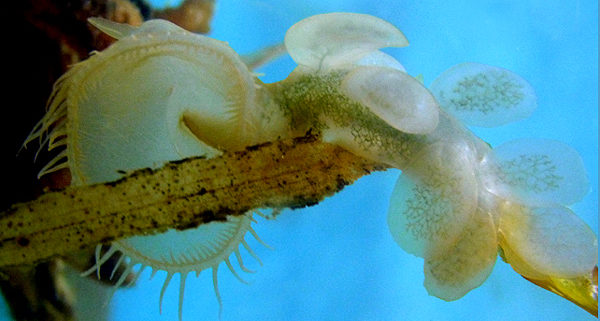Hooded Nudibranch
By Maggie Ikeyima
Common names: Hooded Nudibranch and Lion Nudibranch
Scientific name: Melibe leonine
Size range: Up to 10cm long, 2.5cm wide and 5cm across oral hood.
Identifying Features: The Hooded Nudibranch can be up to 10 cm long, 2.5cm wide and 5cm across the expanded oral hood. The Hooded Nudibranch is a translucent white, yellow, orange, or greenish organism. It has a quite noticeable round oral hood for what could be seen as a “head”. Another feature to note, is that they are more gelatinous than a typical sea slug. When the hooded Nudibranch is taken out of water it gives off a sweet fruity aroma. It smells like watermelon and is produced in glands to act as a deterrent to predators.
Habitat: Hooded Nudibranchs have been seen to live near low tide waters and in kelp forests in deep waters. They are commonly found clinging to eelgrass with their large foot, but they are also found on different seaweeds such as the blades of the Giant Bull Kelp. It is typical to find them from 0- 328m in depth. From what I have seen in the aquarium, the Hooded Nudibranch does not seem to be bothered by sharing its habitat with the many other marine organisms.
Food: The Hooded Nudibranch is a carnivore. They attach themselves to the under-water grasses, for example, and once the they feel their prey the fringes of the tentacles overlap, which then holds the prey and forces it into the mouth. The food then moves through the esophagus to the stomach. The Hooded Nudibranch constantly feeds as long as food is present. They eat planktonic fish, small molluscs, and other invertebrates such as copepods, and zooplankton.
Predators: Predators of the Hooded Nudibranch would include fish, kelp dwelling crabs and sea stars. A quite unique defence for the Hooded Nudibranch is how they are to drop one of their cerata to distract the predator for just enough time to get away. Hooded Nudibranchs are quite entertaining swimmers as they flex their body in a side to side rhythm upside down to escape.
Life Cycle: Hooded Nudibranchs are hermaphrodites. This means that each one has both male and female reproductive organs. When reproducing, two would fertilize each other and then lay their eggs on, most commonly, kelps. Hooded Nudibranchs internally fertilize which is quite rare. Their eggs are tightly coiled in cream or yellow-coloured coil or wave like folds. Hooded Nudibranchs live for approximately a year and die once they lay their eggs.


